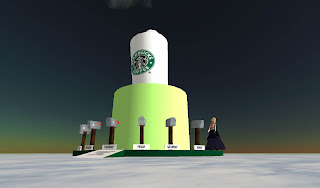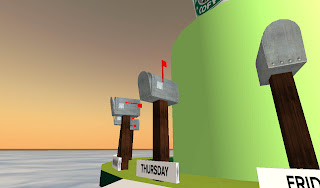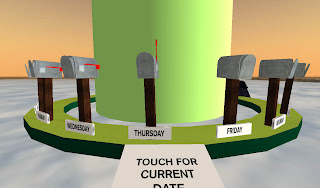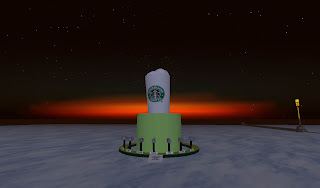
For this part of the project, I was interested in looking at how Second Life could assist with the prospective memory of individuals suffering from memory loss. Prospective memory (in the words of Brian Richards) relates to carrying out an intended action at some specified future time i.e. attending a doctor’s appointments or work. By using technologies offered by Second life such as notecards, external linking, date and time scripts, mailboxes and alert systems, I created a memory architecture that essentially works like online calendar system. The way it is set up is that there is a mailbox for each day of the week. Family members, friends, co-workers can help individuals suffering from memory loss keep their appointments and schedules by dropping off notecards in the respective day of the week mailbox. An upright flag on the mailbox is an indicator that someone has dropped off a message for the user.

These notecards that are received can/ should contain information such as:
when the appointment is
where it is and with a link to the google map
who they are meeting with a link to a picture
why he/ she is meeting them
what he/ she will be doing there.

The text indicating the day of week above the mailbox serves as a reminder that only appointments of that particular day can be dropped in this particular box. Likewise, separating the mail according to each day of the week makes it mentally and visually more clear to the user what day the notecard is relevant for.
By using an interface (mailbox) that is familiar and carries many semantic connotations to the real world, I think that users may feel more comfortable interacting with this system. One of the biggest hurdles I found with Second Life was how hard it was to figure how the interface worked as it was very unlike that of …say the interface of a cellphone or email system. For people who may not understand what a notecard is, this memory architecture can help them look at notecards as letters that you receive in the mail.
Also attaching a familiar artifact to the memory architecture (in this case my starbucks cup) I thought would make it more recognizable and personal to the user. This directly addresses something Guy Proux mentioned in his lecture about patients being able to recognize the environments better when filled with artifacts that are personal to them or speak to an event in their early past that they are still able to vividly remember.

Actually, as a side note here…I found an awesome article by the New York Times about the topic of "Alzheimer and Architecture" where they were saying that “familiar objects helped patients find their own room better than name tags” . Click on the title to read full article. Worth your time!
Cheers
Fiona
No comments:
Post a Comment